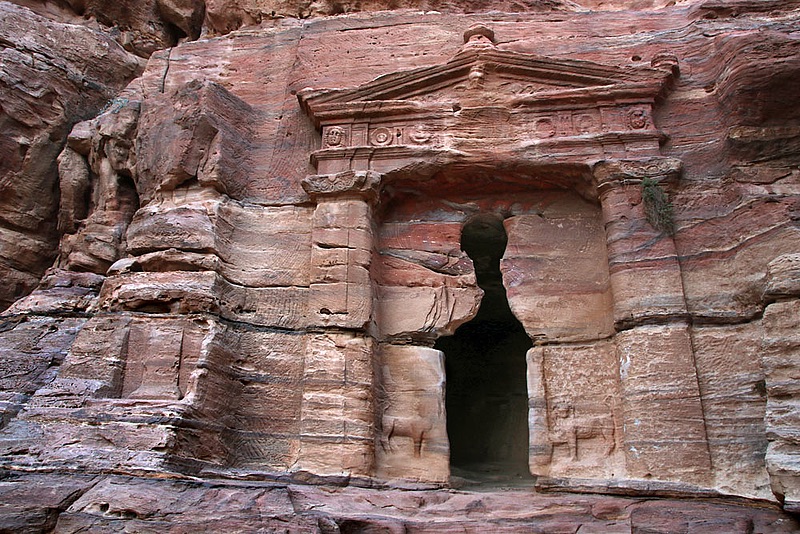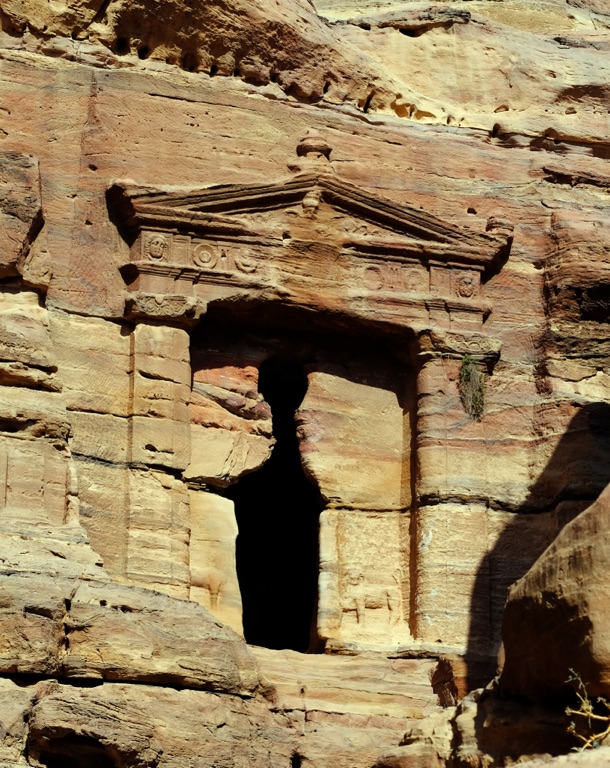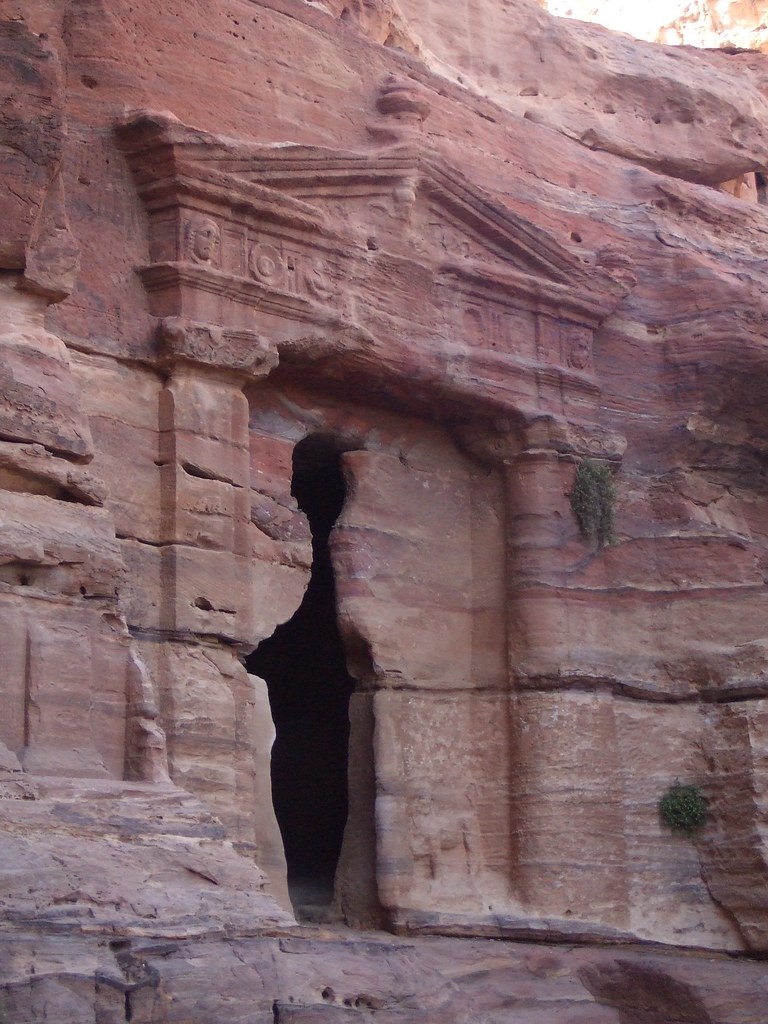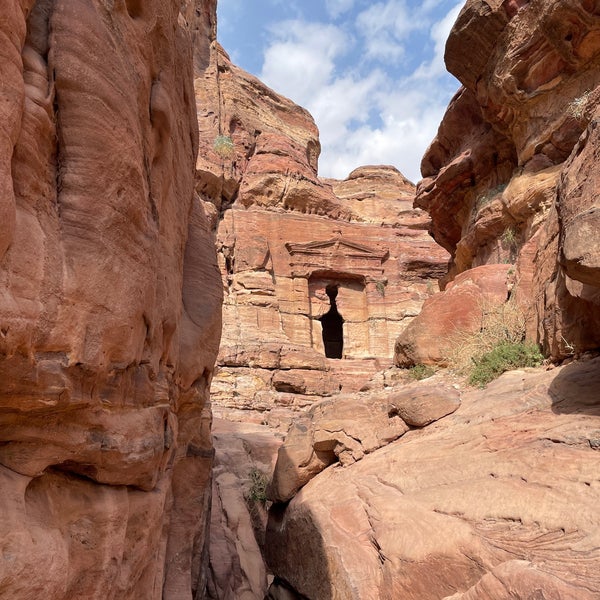Summary
Exploring the Lion Triclinium’s History
Carved into the rosy sandstone cliffs, the Lion Triclinium stands as a testament to the engineering prowess of the Nabateans in Petra. Its facade, adorning the entrance of a tomb, is guarded by two majestic lion reliefs which symbolize protection for the dead. The triclinium itself served as a banquet hall for funeral feasts, showcasing the social customs and spiritual beliefs of the ancient people of Petra. Despite the ravages of time, this monument’s remains tell a story of reverence for the afterlife, underlining the cultural importance of elaborate burial practices in Nabatean society.
Get your dose of History via Email

Architectural Marvel of the Desert
The artistry behind the Lion Triclinium’s construction reveals a deep understanding of both aesthetics and structural design. The intricate carvings and motifs are not merely decorative; they also play a role in reinforcing the structural integrity of this ancient edifice. Situated along the Street of Facades, the site offers a glimpse into the daily life of Petra’s inhabitants and their interactions with the surrounding architecture. Its enduring resilience against natural elements further emphasizes the advanced level of Nabatean craftsmanship of the period.
Preserving Petra’s Priceless Legacy
Today, the Lion Triclinium draws inquisitive travelers from across the globe, eager to unlock the secrets of Petra’s marveled history. Efforts to preserve this archaeological jewel involve meticulous restoration and conservation practices, ensuring the continuation of its story for future generations. Visitors can partake in guided tours to fully appreciate the historical significance and gather insights into the lives once led around this monument. The Lion Triclinium is not simply a relic of the past; it is a living chronicle of human ingenuity and a beacon of heritage in Jordan’s expansive desert landscape.
Historical Background of Lion Triclinium at Petra
Ancient Origins and Significance
Petra, once the capital of the Nabatean Kingdom, is home to the awe-inspiring Lion Triclinium. This burial chamber, graced with highly detailed carvings, dates back to the 1st century AD. Its facade features two lions, symbols of strength, that have captivated scholars and tourists alike. These majestic creatures carved in stone were thought to be protectors of the deceased, guiding their souls to the afterlife. The Lion Triclinium’s purpose, primarily for funeral feasts, reflects the ancient customs of honouring and remembering the dead.
Unveiling the Architectural Mastery
In the heart of Petra’s rocky landscape, the Lion Triclinium showcases the Nabateans’ mastery over rock-cut architecture. Expertly chiseled into the cliffside, this tomb exemplifies their ability to integrate natural surroundings with human craft. The careful design preserved the structure against the harsh desert climate, ensuring its endurance through the centuries. The triclinium layout also features a dining area, where loved ones would gather, sharing meals as an act of remembrance for those passed.
The architectural design does more than fascinate; it provides insights into the technological advancements of the era. For the Nabateans, the Lion Triclinium was not just an artistic statement but also an innovation showcasing their engineering skills. Moreover, it demonstrates their understanding of communal spaces where the living could connect with the sacred realm of their ancestors.

Legacy in Stone
Despite centuries passing, the legacy of the Lion Triclinium endures, speaking volumes about the cultural significance of Petra. This monument serves as both a historical record and an artistic masterpiece, enchanting those who visit it. As a part of a UNESCO World Heritage site, the Lion Triclinium has gained worldwide recognition for its contribution to humanity’s collective heritage. Additionally, ongoing preservation efforts emphasize the importance of safeguarding such treasures for future generations to explore and appreciate.
The Lion Triclinium remains an essential part of Petra’s allure, drawing in those seeking to unearth the stories woven into the very rock it’s carved from. Visitors today can journey through Petra’s Siq, a narrow gorge, to arrive at this ancient dining room, where history echoes through the stone. Its timelessness, fused with mystery, offers a unique window into the lives of the Nabateans, cementing its place as a pinnacle of ancient architecture.
The Discovery of Lion Triclinium at Petra
Initial Unveiling of the Monument
Petra’s Lion Triclinium, while known to the local Bedouins, entered western awareness in the early 19th century. Johann Ludwig Burckhardt, a Swiss explorer, revealed Petra to the Western world in 1812. As he journeyed through the Siq’s narrow passageway, Burckhardt documented numerous tombs, including what would later be known as the Lion Triclinium. This discovery unlocked the richness of Nabatean culture for scholars and piqued the interest of archaeologists worldwide.
Perceptions of Western Explorers
Following Burckhardt, many western travelers ventured into Petra, with the desire to explore its hidden wonders. Among them was David Roberts, a Scottish painter, whose works immortalized Petra’s grandeur in the 1830s. His depictions of Petra’s landscapes included the Lion Triclinium, contributing greatly to its fame. These early representations helped shape the narrative of Petra, enticing future generations to delve into its historical depth.
As the 20th century approached, archaeological teams started methodical excavations in Petra. The Lion Triclinium was a focal point for these expeditions, leading to a greater understanding of its structure and cultural value. Teams from America, Britain, and other nations unearthed artifacts and inscriptions that illuminated the site’s past, piecing together the life story of this locale.

Archeological Advances and Revelations
In the late 20th and early 21st centuries, advancements in archeology brought new techniques to Petra. Digital mapping, drone photography, and ground-penetrating radar have revealed previously unknown dimensions of the Lion Triclinium. Modern methods have empowered archaeologists to explore the site without causing damage, preserving its integrity for continued study.
Today, the Lion Triclinium forms an integral part of the Petra experience, enticing adventurers and scholars alike with its splendor. The monument’s carvings and design continue to shed light on the Nabateans, a historically mysterious people. This grand dining hall, once a place of reverence and memory, now stands as a monument to human creativity and the quest for understanding our ancient past.
Cultural Significance, Dating methods, Theories and Interpretations
Nabatean Cultural Significance
The Lion Triclinium, nestled within the antique city of Petra, is a significant cultural symbol of the Nabatean civilization. Revered for its intricate lion carvings, it suggests a culture deeply invested in the metaphysical aspects of death and afterlife. The lions stand as guardians, a motif that implies a highly sophisticated belief system. As a banquet hall, the Triclinium also indicates the societal importance placed on communal gatherings, particularly in honor of the deceased, highlighting the collective efforts of a civilization to venerate their kin.
Unlocking the Age: Dating Methods Applied
Dating the Lion Triclinium has been a complex task for archaeologists. They’ve utilized a combination of stratigraphy and comparative architecture to estimate its construction to the 1st century AD. Recently, more advanced carbon dating of organic material sourced from within the site has corroborated earlier estimates. These methods collectively paint a more accurate picture of the Triclinium’s creation and use, providing valuable insights into the timeline and evolution of Nabatean culture.
Despite technological advancements in dating, some aspects of Lion Triclinium remain shrouded in mystery. The lack of written records means that interpretations of its use and significance often come from the relics and burial goods found within. The craftsmanship of the site leaves room for speculation about the artisans responsible and their place within Nabatean society. Each discovery acts as a puzzle piece, gradually completing the broader historical picture of Lion Triclinium’s role in Petra.

Theorizing its Purpose and Use
Theories about the Lion Triclinium’s purpose abound among historians. While some suggest it functioned solely as a tomb, others argue that its grandeur indicates a dual purpose, serving both as a tomb and a place for ritualistic banqueting. This theory is supported by the presence of a dais, which could have been used for reclining during feasts – a common practice in the ancient Middle East to celebrate the memory of the departed.
Interpretations of the artistic representations on the Lion Triclinium’s walls are equally diverse. While the symbolism of the lions is commonly accepted to denote protection in the afterlife, the other carvings have sparked debate regarding their significance. Some experts posit that these depict deities worshipped by the Nabateans, while others suggest they might represent mythological events or mortal nobility. The site remains an enigma, fueling continuous academic discourse and research.
Conclusion and Sources
In unveiling the enigmatic beauty of the Lion Triclinium at Petra, we have journeyed through its cultural significance to the Nabatean civilization, delved into the methods and mysteries of its dating, and explored the various theories and interpretations of its existence. The site stands grandly as both a monument to past engineering marvels and as a canvas showcasing the rich tapestry of Middle Eastern antiquity. Its ongoing study grants us glimpses into the ingenuity and spiritual fabric of a lost era, continuing to educate and dazzle the modern observer. While further research may sharpen our understanding, the Lion Triclinium will persist as a captivating relic of human heritage.

For further reading and to validate the information presented in this article, the following sources are recommended:
Or you can check any of these reputable archaeological and historical texts:
Taylor, J. (2001). Petra and the Lost Kingdom of the Nabataeans. Harvard University Press.
Alpass, P. (2013). The Religious Life of Nabataea. Brill.
Bedal, L.-A. (2004). The Petra Pool-Complex: A Hellenistic Paradeisos in the Nabataean Capital. Gorgias Press.
Brown, A. R. (2019). The Architecture of Petra. Oxford University Press.
Markoe, G. E. (1998). Petra Rediscovered: Lost City of the Nabataeans. Harry N. Abrams.

